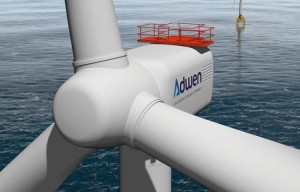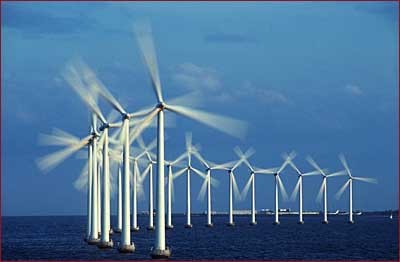In a recent report on « Costs of renewable energies in France » (ADEME, December 2016, www.ademe.fr ), ADEME (the agency in charge of new energy development) stresses that their cost is falling sharply but that their development depends on a large number of technical, economic and geographical factors. In its report as in all international studies, ADEME distinguishes between terrestrial and offshore wind. Wind power has made a real breakthrough in the electricity mix of many countries, accounting for 6% of the world’s electricity generation capacity (3% for solar power). In France, installed onshore wind capacity exceeded 11 GW at the end of 2016 (41 GW in Germany and 129 GW in China …). In France, wind power generation (only terrestrial for the time being) started in 2005, and in 2016 it exceeded 20 TWh, contributing to 4% of the domestic electricity production. The target for the development of wind power production capacity, set by the Multiannual Energy Program (PPE 2018-2023 ) being in the range of 22 GW to 26 GW for 2023, this objective will be difficult to achieve. Most energy scenarios « foresee » a strong increase in electricity production through renewable energy chains, particularly wind power. Thus, the most proactive one, proposed by the IEA (AIE, World Energy Outlook 2016, Paris 2016, www.iea.org ), which is compatible with the objectives of the global warming limitation, assumes a 8.6% yearly growth of world wind generation (mostly terrestrial) by 2040, being 5.5% for the EU and almost 10% for China, which would be the largest wind power world producer.
ADEME estimates that the total cost of producing ground-based wind power would be in France in a range of 54 to 108 € / MWh for standard machines, and in a range of 50 € to 94 € / MWh for wind turbines with a large diameter of the rotor their productivity being larger; these ranges being roughly equivalent to the cost of the kWh produced by nuclear power and hydroelectricity (they depend on the location and assumption used for the discount rate). The off-shore wind situation is less optimistic. The cost of offshore wind power according to the ADEME would be in the range of € 123 / MWh and € 227 / MWh for wind turbines fixed on platforms and even higher for floating wind turbines (between € 165 / MWh and € 364 € / MWh). Differences in cost can be explained by the need to link offshore wind turbines to the coast by submarine cables. For the time being, there is no production of electricity by offshore parks in France. Six off-shore wind farms are to be built off the French coast from Le Tréport, in the north, to the Yeu and Noirmoutier islands farther south (with a power of nearly 500 MW each).
The rise in wind power production has been made possible by the reduction in wind turbine manufacturing costs and the technical advances of the turbines. The majority of newly installed ones, in the world, had a nominal power of 2.3MW. The future of wind power depends on continued cost reductions. A recent report published in September 2016 by several US laboratories (Wiser, R., et al., « Expert elicitations survey of future energy costs », Nature Energy 12 September 2016, www.nature.com) gave the conclusions of their investigation of possible wind turbine technology developments by 2030, comparing prospects for the European and American markets (there are as yet no wind farms operating in the United States). These experts evaluated three « models » of wind turbines: land-based machines, off-shore wind turbines attached to the bottom of the sea, and floating platforms supporting a wind turbine. The first one is a  conventional technique with a 3.25 MW turbine fixed at the top of a 115 m high mast and with 135 m diameter rotor blades. The wind turbines of the second model would have a power of 11MW (slightly higher than the engines of a train of the Atlantic French TGV) with a 125 m high mast and with a 190 m diameter blades. We would thus enter the era of gigantism. The power of the wind turbine on a floating platform would be only 9MW with a turbine having the same characteristics. The majority of experts anticipates a reduction in the cost of producing wind electricity by 24 to 30% by 2030 and 35 to 41% by 2050 for the three types of wind turbines, which would obviously be considerable. The capacity (the ratio between the electrical energy supplied and the energy delivered at maximum power is at best 40%). For each of them it would be increased by 4 to 9%.
conventional technique with a 3.25 MW turbine fixed at the top of a 115 m high mast and with 135 m diameter rotor blades. The wind turbines of the second model would have a power of 11MW (slightly higher than the engines of a train of the Atlantic French TGV) with a 125 m high mast and with a 190 m diameter blades. We would thus enter the era of gigantism. The power of the wind turbine on a floating platform would be only 9MW with a turbine having the same characteristics. The majority of experts anticipates a reduction in the cost of producing wind electricity by 24 to 30% by 2030 and 35 to 41% by 2050 for the three types of wind turbines, which would obviously be considerable. The capacity (the ratio between the electrical energy supplied and the energy delivered at maximum power is at best 40%). For each of them it would be increased by 4 to 9%.
By 2050, onshore wind turbines would be the most competitive on the world market: the kWh cost would go from 70 € / MWh in 2014 (close to market parity) to around € 40 / MWh (in € 2014). The costs of the two other off-shore sectors are approaching 80 € / MWh instead of € 120 / MWh in 2015 for fixed off-shore wind turbines (platform wind turbines being not yet existing). The increase in the height of the masts and the size of the rotors is the main factor in decreasing production costs. For offshore wind, the possibility of transporting all components by sea would lower the construction costs.
Will the evolution towards the gigantism of the wind turbines become concrete (see photo of an Adwin wind turbine)? The biggest project in preparation is the Dogger Bank farm in the United Kingdom (in the North Sea on the east coast of Yorkshire), it is a plan for building a 1.2 GW plant (200 wind turbines with 6 MW of power each). The German manufacturer of wind turbines Siemens envisages even bigger possibilities, since it plans to inaugurate in Cuxhaven, in 2017, a factory to manufacture 7MW wind turbines. A research project funded by the EU’s Research Framework Program is modeling future 20 MW offshore wind turbines (the Upwind and Inwind projects), another step in gigantism: the mast would peak at 150 m with a rotor blade diameter of 250 m for the rotor , it would weigh 770 tons!.
The race to the gigantism for wind turbines is an option opening a way to increase their production capacity, especially for off-shore (it increases all the more as the rotor is at high altitude because the blades capture winds at higher speed), from 2 to 3 MW (see also P. Papon, « Towards a gigantism of wind turbines? » Futuribles Vigie, December 2016 www.futuribles.com and IFP Energies nouvelles, Panorama 2016, “Offshore wind turbine”, www.ifpenergiesnouvelles.fr ). The mechanical strength of the rotor blades will be a critical point that requires a research effort on materials. The choice of locations for wind turbines, regardless of their size, presupposes a very good knowledge of the wind regimes and therefore a meteorological database over several years, as highlighted in a recent JRC report (JRC, European Commission, “EMHIRES data set, Volume I, Wind Power generation, 2016”, www.ec.europa.eu/jrc ).
Wind power is definitely on the rise and a realistic guess in experts’ forecasts (meanwhile they rarely take account of ancillary costs, notably the storage of electricity generated outside peak hours), and one can safely estimate that land-based wind will be competitive in France, as in most European countries, around 2020, the offshore technique would probably take at least a further decade to emerge and be competitive. With large-scale wind turbine projects, the sector will probably be not far from its technical limits.
